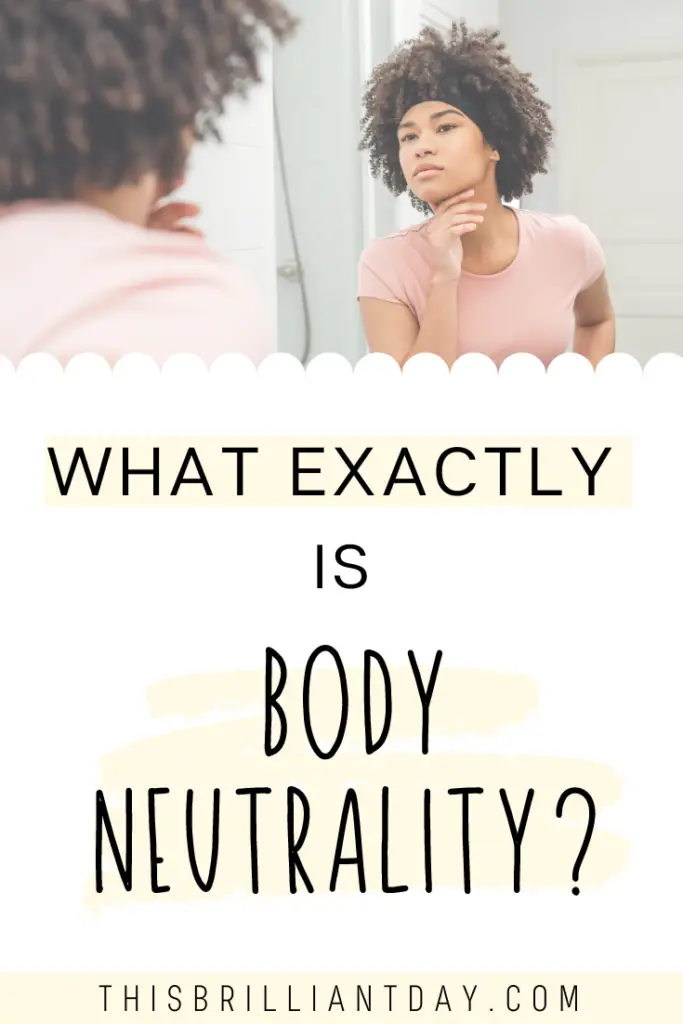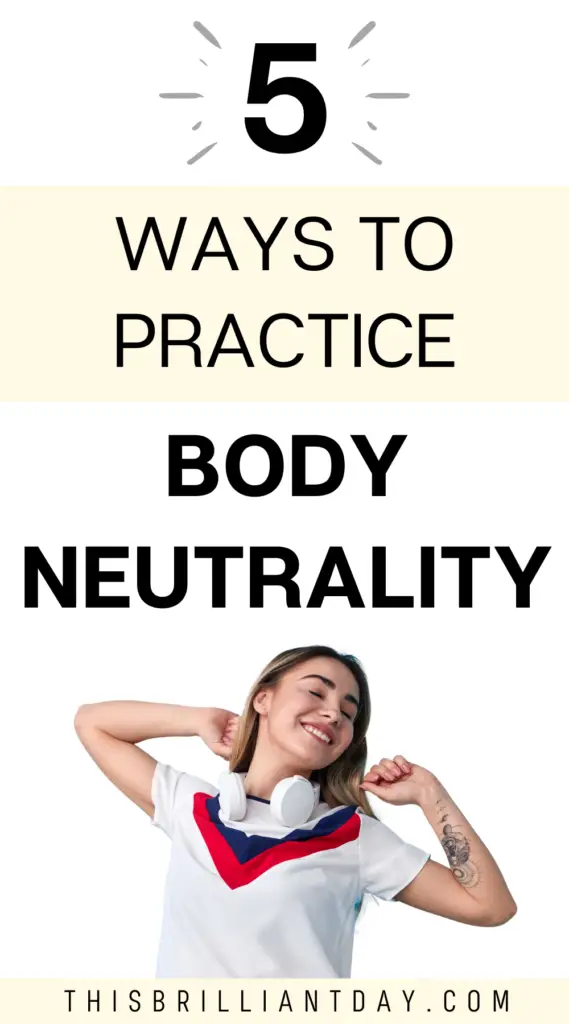This is a guest post written by Kate, the creator of Love My Anxious Brain. Kate’s blog is packed full of fantastic life advice and free resources for Anxiety Warriors and I highly recommend paying it a visit. You can learn more about Kate on her About page.
* * *
Have you stumbled across “body neutrality” while searching for ways to feel more confident about your body?
It’s not as well-known as body positivity. But for a lot of people, body positivity just doesn’t sit right. The focus on “loving your body” can feel like too much pressure, when you’ve spent years feeling the exact opposite.
This is why body neutrality is gaining popularity. You might be wondering how it can help you tackle body image anxiety. Read on and I’ll cover what body neutrality is, why it matters and how to practice it.
And along the way I’ll be sharing thoughts from five women I interviewed on Twitter about their body image.

Women Talk About Their Body Image Issues
I started by asking all five women the same question: How do body image issues affect your life?
Two of them, happily, didn’t feel they had many body confidence issues. Here’s what the other three had to say:
Trigger warning for discussion of eating disorders.
Valarie: “Body image has had a terrible impact on my life. Growing up, what I was and wasn’t allowed to eat was dictated by the whims of whatever diet my parents happened to be on at the time – and they’ve tried them all. My sister and I were both a healthy weight, but we were still dragged along for their obsessive weight measurements, comparisons, and bread that felt like sandpaper in your mouth.”
Roxy O’Rourke, a team member of the One Athlete Project: “I grew up as a dancer, primarily ballet, dedicating close to 40 hours of my time each week to class and rehearsals. Through this ‘hobby’, and the prominent focus on the body’s appearance and capabilities in ballet, I, alongside many of my fellow dancers developed an eating disorder. This stemmed directly from a poor body image. I battled binge eating disorder for close to 10 years. I no longer directly struggle from an eating disorder, but still experience poor body image days where I struggle to balance exercising, eating, and self-acceptance. I also indirectly struggle from body image issues through knowing my friends/classmates also struggled for years, and also having had a best friend pass away from an eating disorder.”
Victoria: “Now… not massively, but it’s taken nearly 10 years. I had bulimia for 7 years and it really wasn’t a control thing, it was a body image thing. I felt fat and I hated my body but I couldn’t starve myself so I made myself sick instead. I never ended up losing weight though and I still hated my body. Now I think about how much trauma I put my body through and I would never go back to doing that. I still hate my body though.”
Reading all of the above makes me incredibly sad. I can relate to it on a personal level, as I struggled with an eating disorder for over a decade, too. I’m sad about all those collective years (and in one case, a whole life) lost to obsessive measurements, restrictions, shame and self-blame.
This is why body neutrality matters so much. It’s a way to disconnect our sense of self-worth from our size or shape. And it’s how we can turn down the volume on toxic social expectations and criticism of our bodies.

Where Body Shame Comes From
Unless we were unlucky enough to receive criticism about our appearance, as small children we were naturally body neutral. Our bodies existed so we could do things like run about the park and eat pizza. (Probably at the same time, if you were anything like me as a child.)
Sometimes our bodies got sick and needed rest. They often got muddy and messy. But unless we dealt with serious illness or injury, they were just there. They were how we experienced the world and they were neither “good” nor “bad”.
Body image anxiety isn’t something you’re born with. As you grew up, you learned to be self-conscious about your body. At first, you probably didn’t think about your appearance much. You pulled funny faces in photos and didn’t demand that unflattering ones be immediately deleted. Getting dressed, your biggest problem was whether you’d be allowed to wear your Disney sneakers to school.
Then you got a little older and suddenly started comparing yourself to your friends and the models you saw in magazines or on Instagram. Taking photos stopped being fun – it became an anxiety-ridden process of trying to look a certain way. Choosing clothes became a longstanding feud between yourself and the mirror.
In some ways, it’s just a normal part of growing up. We start being aware of social expectations and wanting to fit in. But unless there’s a balancing force, your entire relationship with your body becomes based on whether you’re happy with how it looks.

So What Exactly is Body Neutrality?
And that’s where body neutrality comes in – it’s that “balancing force”. Unlike body positivity, which is all about learning to love the unique way your body looks, body neutrality is about remembering that your body doesn’t exist just to be looked at and judged.
In a nutshell, it’s a focus on what your body can do for you instead of what it looks like. It’s a lack of self-consciousness that gives you the freedom to enjoy actually living in your body.
For those of us who struggle with body image issues, possibly the last time we experienced body neutrality was as small children. Remember when food was just food, and didn’t have the power to make you feel guilty? Or when a piece of clothing not fitting right was just funny and didn’t have the power to make you feel ashamed?
Body neutrality means taking away those powerful negative emotions from your everyday experiences.
It means not judging your worth based on how your body compares to society’s perceived beauty standards.
Most of all, it means respecting your body, however it looks and whatever state of health it is in.

How Can I Become Body Neutral?
I asked my five interviewees for their body neutral experiences: times when they’ve felt comfortable in their own skin or appreciated what their body can do (rather than how it looks).
Both of the two women who don’t currently have body image issues have used body neutrality to overcome past issues, as teenagers. But what’s interesting is that neither has gone out of their way to be body neutral – it was just something that happened naturally over time.
Sophie Harriet says that she doesn’t “consciously focus” on what her body can do for her. She does appreciate everything it can do, but it’s not something she thinks about much. “When I was a teenager I was a lot more insecure about my body and the changes it was going through as I grew up.” She added that nowadays, “although there are certain things about my body that I’m not keen on, I overall accept them.”
Natalia Wiatr overcame issues with her appearance when she was younger, too. She says, “I didn’t like my nose as a young girl. Then I learnt that I wouldn’t be myself if I had a different nose. My face wouldn’t be my face anymore.” And becoming a mother has strengthened her belief in focusing on what’s important: “I do want to look good, but it’s not my priority. My priority is to feel good. As a mom, I discovered that the most important thing is being present. Kids don’t care how I look.”
Don’t worry if (like me), body neutrality hasn’t come naturally to you and you’ve carried those teenage insecurities into your adult years. For many of us, we have to make a conscious effort to learn how to practice body neutrality. With practice, it can become our natural mindset.

5 Ways to Practice Body Neutrality
- Make a list of everything you appreciate that your body lets you do. E.g. it lets you hug your loved ones, listen to your favourite music, feel the crisp softness of fresh bed linen, play games with your dog or kids, wallow in a bubble bath, and taste your morning coffee.
- Exercise for fun or for your health (not for changing your appearance). Roxy says, “I feel most comfortable in my own skin when I am running. I choose to exercise outdoors now, as a runner, rather than in a studio like the past-me did as a dancer. Through running I have learned to focus more on the environment and what my body is capable of achieving, rather than what my body looks like.”

- Show your body you respect it by listening to what it needs. Body neutrality takes away the guilt you’ve learned to feel about your normal physical needs. It’s a reminder that calories nourish and keep you alive; you’re not being “good” if you avoid them or “bad” if you don’t. And exercise is a physical need, but it should never be a punishment for “eating too much.”
- Set boundaries around body-shaming influences: Does a certain “friend” regularly make you uncomfortable with personal comments about your body? Is your Instagram feed depressingly full of influencers in bikinis? Do you need to talk to your mother about how often she comments on your weight?
- Read more about body neutrality: I’ve found that the more I read, the less anxious I feel about my appearance. But it takes some time to really sink in, because it’s easier to think about something that’s positive or negative than it is to focus on something “neutral”.

Body Neutrality Resources
Here are some helpful guides and resources, if you want to learn more about body neutrality:
Body Positivity vs Body Neutrality: a Simple Guide
A potted history of body neutrality and what makes it different to body positivity (this one’s from my blog).
Why I Love The Body Neutrality Movement
A passionate blog post about no longer basing our sense of self-worth on how we feel about our bodies.
5 Steps to Body Neutrality
This article has a really helpful definition of body neutrality and some practical steps to achieving it.
Body Positivity & Self-Love versus Body Neutrality
If you’d rather listen than read, here’s a half-hour podcast episode on body neutrality, from Holistic Health Radio.
Final Thoughts
I hope these tips were helpful to you, in learning what body neutrality is and how to practice it in your daily life.
Thanks so much to Sophie, Victoria, Valarie, Roxy and Natalia for contributing to this post. The more we talk openly about our body image issues, the more we learn from and support each other.
If you have any thoughts or questions on body neutrality, please do share them in the comments below!
* * *
Kate, thank you so much for writing this guest post for my blog. I enjoyed taking part by answering your questions, and I hope my readers have learned as much about Body Neutrality as I have! I would also like to thank all the other women who contributed to this post – it was great to read your insights and experiences.




This is such a great resource on body neutrality that I’m sure will help many! I really loved seeing this all come to together with everyone’s unique perspectives. Love it!
I’m so glad you enjoyed reading this! I am hoping that it will be a helpful resource for many!
I love this concept – especially the fact that it can easily transition from stage to stage of our lives. There are many people who struggle when their body changes, whether it be from pregnancy, a health complication, etc. At that point, they feel like their body positivity efforts are lost or starting all over again. However, body neutrality is different. You can love your body for the fact that it could carry that beautiful new baby, giving life, or because it had the strength to overcome illness and still allow you to enjoy the things you love in life.
That’s a beautiful way of putting it! Body Neutrality definitely has an advantage over Body Positivity when it comes to processing big changes in our bodies.
Wonderful and inspiration post and one that I can truly learn from. I need to practice body neutrality because I often have a terrible body image of myself. Thanks for this uplift.
I’m so glad you found this post helpful and inspirational. I hope body neutrality will help you to see your body in a different light xx
I’ve never heard of body neutrality- so this was a very informative post for me. I think it’s so important to remember what our bodies do for us each and every day, and I love that you’ve included different opinions and ideas here. Thank you for sharing this post x
I’m so glad that this post has introduced you to the concept of body neutrality! I agree, it’s so important to appreciate our bodies for what they can do. x
I love this idea! Great more healthy concept
I agree, it’s a healthy mindset to get into!
What an interesting take on our bodies. As I grow older, I feel so different about my body and how others view it!
Rosie
I hope you are feeling better about your body as you grow older 🙂
This is a new concept for me as well!
I’m glad to have introduced you to the concept! x
Ever since I first heard of body neutrality it’s something I’ve been aiming for! Great post 🥰
Becky | Uptown Oracle | The Blogger Group
Thank you! That’s great that you’re aiming for body neutrality 🙂
This is such an important topic. I’ve been trying to train myself to be more neutral which at the moment consists of only allowing quick glances in the mirror. Otherwise, any longer and I start being critical about the things I dont like.
That’s great that you’ve been trying to train yourself to be more neutral. Thank you so much for reading! x